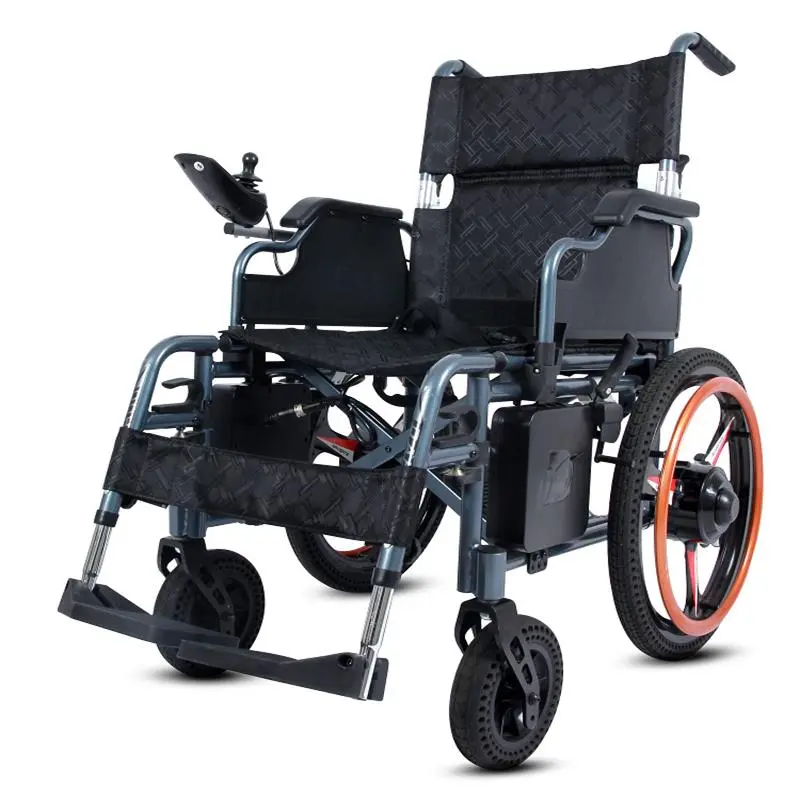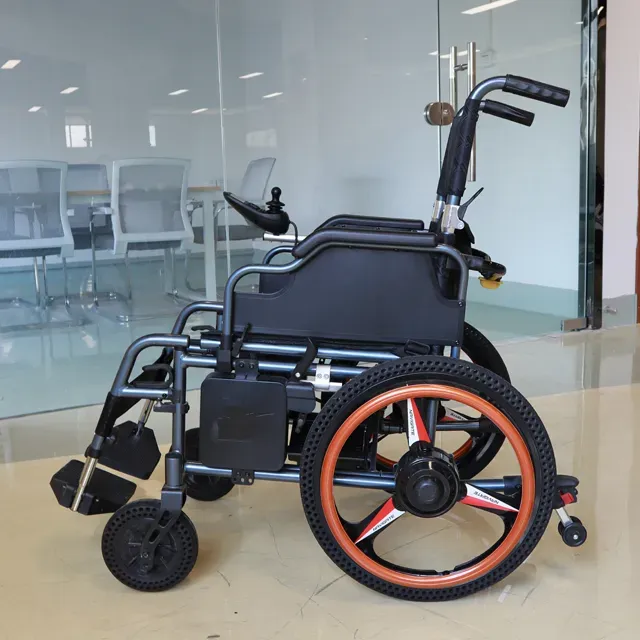Powered wheelchairs offer a high degree of independence and mobility convenience to those with limited mobility, but they also raise an important question: How long can an elderly person safely sit in a power wheelchair? What health risks does prolonged sitting pose? How should caregivers arrange for rest and repositioning to mitigate these risks?
Below, we will explain each of these points in detail, providing a specific action checklist and key monitoring points.
Why limit wheelchair usage time?
While powered wheelchairs significantly improve elderly individuals' ability to move independently, prolonged sitting can lead to a series of preventable health problems. Key pathological and physiological mechanisms include:
1. Pressure ulcers (pressure injuries) caused by sustained localized pressure
Sitting places significant pressure on bony prominences such as the sacrum, ischial tuberosity, and greater trochanter. Prolonged pressure can lead to localized blood flow depletion, tissue hypoxia, and skin and soft tissue necrosis. Pressure injuries are one of the most common complications for manual and powered wheelchair users.
2. Increased risk of lower extremity venous congestion and deep vein thrombosis (DVT)
Prolonged inactivity leads to insufficient calf muscle pump function, slowing blood flow and increasing the risk of thrombosis (similar to "economy class syndrome"). The risk is even greater for those with cardiovascular risk factors or coagulation abnormalities.
3. Musculoskeletal degeneration and pain
Prolonged sitting can easily lead to back and lower back muscle fatigue, neck and shoulder discomfort, and hip and knee stiffness, leading to functional degeneration and decreased mobility.
4. Impacts on the respiratory, urinary, and digestive systems
Continued sitting can impair diaphragmatic movement, reduce ventilation efficiency, and increase the risk of urinary tract infections and constipation (especially in elderly individuals with reduced mobility).
These mechanisms indicate that "sitting duration" is not simply a matter of comfort but a clinical issue related to safety and long-term health. Therefore, evidence-based recommendations and actionable measures are necessary to regulate "time spent in an electric wheelchair" and "frequency of rest breaks."

How long can an elderly person sit in an electric wheelchair?
Different institutions and studies have detailed, though not entirely consistent, recommendations regarding "sit time" and "position change frequency" in power wheelchairs. The core consensus is: frequent weight shifts/pressure relief and avoid remaining in one sitting position for extended periods.
1. Short, frequent pressure relief
While sitting in a power wheelchair, try to perform active or passive pressure relief maneuvers (e.g., leaning forward, tilting sideways, or lifting the buttocks off the seat for 30–90 seconds) every 15–30 minutes. Examples include leaning forward with the chest onto the knees or rolling sideways, each held for 30–90 seconds to promote blood flow and tissue reoxygenation.
2. Continuous sitting should not be excessively long
For most elderly power wheelchair users, a single, uninterrupted sitting session should not exceed 2–3 hours without changing position or leaving the seat (even if pressure relief maneuvers are used, genuine short periods of leaving the seat/lying position should be included).
3. Daily maximum sitting time
Based on safety and ease of implementation, a conservative and practical upper limit for power wheelchair users is four hours per day. Exceeding this cumulative time, especially without adequate pressure relief and repositioning, significantly increases the risk of pressure ulcers, venous thrombosis, and muscle atrophy.
(Friendly reminder: For elderly individuals with pre-existing skin breakdown, diabetic peripheral circulatory disorders, known coagulation abnormalities, or a recent surgical history, it is recommended that a professional rehabilitation or wound care team evaluate and strictly follow an individualized plan to limit sitting time and determine whether they can tolerate the 4 hours of cumulative sitting time in a power wheelchair.)

What are the specific health risks associated with exceeding the recommended time?
If elderly individuals sit in power wheelchairs for extended periods without effective rest and pressure relief, the following problems may occur:
1. Formation or worsening of pressure ulcers (pressure injuries)
Mechanism: Prolonged pressure on localized soft tissue leads to impaired microcirculation, tissue hypoxia, and necrosis. Typical locations include the ischial tuberosity, sacrum, and greater trochanter. Existing guidelines emphasize the importance of pressure redistribution and cushion selection when sitting.
2. Risk of Deep Venous Thrombosis (DVT) and Embolism
Mechanism: Lack of lower limb muscle pumping leads to slowed venous return and thrombosis, especially in those with coagulation risk factors. The concept of "wheelchair thrombosis syndrome" has even been proposed in the literature to highlight this risk.
3. Muscle and Joint Stiffness and Functional Degeneration
Excessive single-use and prolonged immobility of electric wheelchairs can lead to decreased muscle strength and limited joint mobility, reducing the likelihood of regaining independent mobility in the short term.
4. Respiratory and Metabolic Impacts
Long-term sitting in an electric wheelchair can restrict chest mobility, impairing ventilation. Furthermore, prolonged sitting can negatively impact blood sugar, blood lipids, and blood pressure.
5. Urinary Tract and Digestive Problems
Constipation and the risk of urinary tract infections increase, especially in those with urinary incontinence or chronic catheterization.
6. Psychosocial Impacts
Prolonged sitting limits social interaction and mobility, potentially exacerbating depression, loneliness, and a decreased quality of life.
These complications do not manifest instantly but rather develop through repeated accumulation of micro-injuries and functional deterioration. The key to prevention is frequent stress relief, regular sitting, using an appropriate cushion, and moderate activity.
Powered Wheelchair: How to Achieve a "Four-Hour Maximum Daily Use"?
Below is a sample daily sitting routine and a stress-relieving exercise checklist that can be directly implemented by family caregivers or institutional caregivers.
A. Daily Sitting Arrangement
(Applicable to elderly individuals with limited mobility who can adapt to passive/active repositioning)
• Morning (after waking up): Get up, stand, and sit in a powered wheelchair (for breakfast or short trips). It is recommended that the first sitting session should not exceed 90 minutes, with weight transfer/standing up in between.
• Morning Activity: If you need to go out or participate in activities, schedule a 30-60 minute sitting session, performing forward or side leaning movements every 15-30 minutes.
• Midday Break: It is recommended to return to bed or a sofa and lie flat or semi-reclining for 30-60 minutes to effectively relieve stress and restore circulation. • Afternoon: Arrange another cumulative sitting time of no more than 90–120 minutes (including several pressure relief sessions). Prioritize a lying rest session at the end of the afternoon.
Overall accumulation: Accumulate all sitting sessions, limiting total daily sitting time to approximately 4 hours (this can be reduced depending on individual needs). If prolonged sitting is necessary (such as when traveling all day), more frequent pressure relief and a better electric wheelchair cushion and tilt support are required.
B. Pressure Relief Exercises
• Forward Lean (Forward Pressure Relief): Lean forward with your upper body and place your hands on your knees or armrests, lifting your buttocks off the seat for 30–90 seconds. This is suitable for motorized electric wheelchairs or for those who can exert force with their upper limbs.
• Tilt/Roll: Lean to one side, lift your hips, hold for 30–90 seconds, then switch sides. This is suitable for those with partial trunk function. • Tilt/Recline Wheelchair Functionality: If a power wheelchair has a tilt/tilt-in-space function, mechanical adjustment can be used to change the pressure distribution during sitting, achieving pressure relief (professional guidance is required for use).
• Short breaks from the seat: If conditions permit, arranging short breaks from the power wheelchair (standing or lying down) every 1–2 hours, even for just 5–10 minutes, is more effective than continuous sitting.
C. Caregiver Monitoring Checklist (Before/After Each Sitting Position/Hourly Inspection)
• Skin inspection (sacrum, ischial spine, lateral thighs) for redness, warmth, or damage;
• Check the seat cushion and sitting posture for stability (sag or slip);
• Lower extremity swelling, pain, or cyanosis (suspected DVT requires medical evaluation);
• Localized pain or numbness reported by the elderly.

Powered Wheelchair: How to Choose Configuration to Reduce Risk?
Proper power wheelchair configuration and fit are crucial for extending safe sitting time, preventing pressure ulcers, and improving comfort:
• High-quality pressure-redistributing cushions: Air, gel, or multi-chamber distributed cushions can significantly reduce localized peak pressures. These cushions should be selected and regularly inspected according to the recommendations of a professional wheelchair service.
• Tilt/recline function: These functions can modify pressure distribution without changing hip position, making them suitable for high-risk individuals who are unable to actively relieve pressure frequently.
• Appropriate seat depth and lumbar support: These functions ensure a neutral pelvic position and prevent sacral sitting, which helps reduce sacral pressure.
• Pressure monitoring or reminder devices: Some devices or add-ons can record sitting time and remind the user/caregiver to relieve pressure, facilitating compliance with frequency requirements.
When is it necessary to more strictly control the time spent in a manual or power wheelchair?
Elderly individuals in the following situations should undergo stricter sitting management, potentially requiring a lower upper limit than the "4 hours/day" recommendation. A personalized plan should be developed by the healthcare team:
• A history of moderate to severe pressure ulcers or current unhealed pressure ulcers;
• Poor healing due to diabetes, peripheral vascular disease, or malnutrition;
• Inadequate anticoagulant therapy or extremely poor mobility (needing assessment for DVT risk);
• Severe sensory impairment (e.g., spinal cord injury) that prevents the perception of tingling or tenderness, requiring additional care and more frequent repositioning.
Recap: How long can elderly individuals sit in a power wheelchair?
Taking into account the fragility of the elderly, we offer practical daily guidelines:
1. Perform pressure-relieving maneuvers every 15–30 minutes while sitting;
2. Avoid sitting for more than 2–3 hours at a time;
3. A safe guideline is to conservatively limit the total time spent in a power wheelchair to approximately 4 hours or less per day.
Can I visit your production base for inspections?
Absolutely. We welcome visits to both our R&D and production facilities located in Changhongling Industrial Park, Nanhai, Foshan. As a reputable ISO9001/ISO13485 certified factory, we maintain full transparency in manufacturing processes for electric wheelchairs, hospital beds, rollators, commodes, shower products, and walking aids.
Buyers arranging bulk purchases or OEM customization are invited to inspect quality control, meet our engineering team, and negotiate quotes, pricing, and factory-direct deals.










